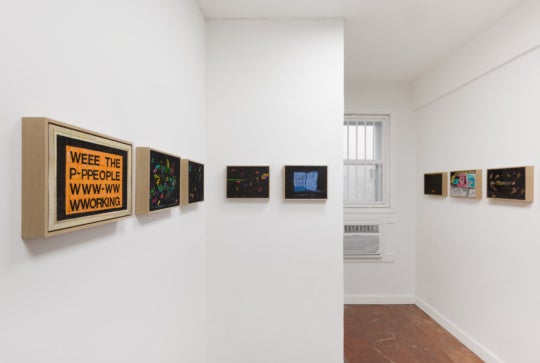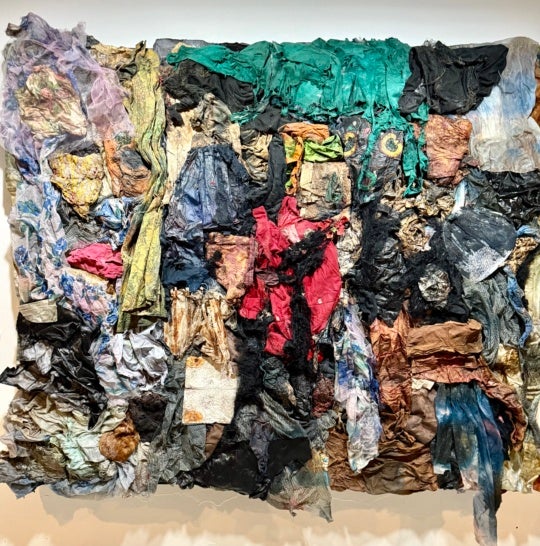
“If you want to be taken seriously as an artist, you cannot avoid painting.” This is what 70-year-old, New York painter David Diao thinks. He is not alone. Like so many professional artists, his practice sticks very close to models of contemporary success based out of New York, London, and Berlin. Choosing any other medium would be a fault in ambition.
Not one painted figure can be found in the Painters Panting show at the Contemporary. Nor have outsider or vernacular forms been included—no painted signs, houses, gold-framed oils made by bored suburbanites, or realistic landscapes made by Sunday painters in their community art, plein-air classes. This exhibition focuses tightly on the traditions surrounding Abstract Expressionism, the holy moment of American twentieth-century fine art. The curation cleverly riffs on a notorious art film; Painters Painting (1973) documents the rock stars—Rauschenberg, Stella, Pollock, de Kooning, Johns, Warhol, Frankenthaler—of the New York Art Scene from 1940-1970. Twisting the words into “Painters Panting,” curator Stuart Horodner humorously acknowledges the additional non-romantic layers: the requisite desire, ego, exhaustion, anxiety, sensuality, and drooling expressive messiness. I dare say, although the exhibit is particularly pleasant to walk through with its collection of large, colorful, exquisitely textured artworks made by people who really know their craft, attending the artist talks was the most critical piece.

Most serious painters are painfully aware of their careers. Conversely, other types of artists can get stuck in opposition—a different type of panting altogether. Generations try anew to avoid or reject both painting and the heavy baggage of the white space. But painters are the ones who embrace the tradition with its connections to wealth and power head-on, unabashedly attracted to the decadent fruits that it can bear. Many painters want to stay critical and on the edge of society in order to align with their artist identities, but are beholden to protective institutions and insular boutique industries. You have to give artists credit for being so self aware of the situation. Thomas Lawson acknowledged this paradox in 1981, calling it “critical complicity.” He thought that painting might be used as camouflage for its own subversion. “This subversion was to shake the value structures of the art world, but much the opposite occurred. Subversion was contained there, at the point of painting, and reversed into complicity.” Painters working at the top of the game, regardless of how they tried to infuse works with criticality, ended up cooperating with an often corrupt but potentially lucrative system. The market for paintings continues to burst forth regardless of any political ambivalence. You can see why artists posthumously choose other mediums.
Forty years later, we find ourselves sort of celebrating the advantages of painting’s complicity. Professional painters basically must accept the authority of the established system. In both senses of the word, painters are the last great materialists in a world dematerialized by technology; they chose lifetyles which grow more eccentric with every passing year. They are ruled not by electronics, but by the physicality of materials—pigments, canvas, studio spaces, light, images made by hand and body. Either out of stubborn love of this tactical medium or a desire to be at the top of the pyramid, they are terribly dependent upon a class of people who can afford to keep and care for their wonderful, expensive, superfluous, and demanding two-dimensional objects. Louis Camnitzer calls it “trading enormous rocks.” Every expert has pronounced it dead. Are we beating the hell out of a decades-dead animal? Are we grief-stricken, chasing the ultimate, ever-living ghost? Why do we not want to let painting go?

Despite any informed cynicism, I keep coming up with the same conclusion: the loss of painting is unbearable. Everyone who cares hyperventilates. Perhaps, the dawning conclusion is that we really do not want to live without the tradition of fine art paintings. Paintings are deeply symbolic objects (not unlike real books). For better and for worse, nothing is more identifiable as “art” than paintings and all that is associated with them. But are we choosing to stay formally chained to art history at the risk of developing more relevant, democratic, and sustainable ways to express art? (And, really. . .do great paintings need to be so expensive or so codified with class?) So, the nostalgia mounts for celebrity artists who worked in the golden eras. This longing for the easy streets of painting’s past not only relates to our deep love of the form and mythology but also our fear that such heydays are lost and gone forever.
Thus, contemporary painters are stuck in a complicated situation of privilege and willpower, which can breed a certain neurosis. I certainly noticed it listening to three artists talk about their work at the Contemporary. They all struggle overtly with content and purpose. It seemed as if the sensual part of painting was played down. Instead, they almost over-justify their practices by attaching theoretical meaning. Although I am a proponent of deeper content in artworks, I may somewhat reverse my stance in regards to painting. Sometimes a giant hot pink and orange paint stroke breathily layered next to gold and emerald green is just a fantastic thing to experience. Period. Nothing wrong with that. Preserving visual experiences that are bodily, certainly takes on new meaning as our society becomes more oriented towards the virtual.

Judy Ledgerwood is a great example. Obviously an ardent colorist, she wore a fuchsia dress and red sweater, accidentally matching the family of bright colors in her “wall work.” The whole room installation in the side gallery is resplendent with swooping bands of dripping color and sloppy decorative florets in metallic paint. When asked why she paints directly on walls, she related an early awakening. She and her artist husband grew up in the New York scene of the 80s and were both shocked by the reality of the gallery business. They witnessed that even for painters like Robert Mangold at Pace Wildenstein, artworks were sold to match furniture. And so Ledgerwood attempted evasion by painting directly onto walls. (But of course, she did not go outside to the city streets to do this; she instead painted the walls of galleries and private homes.) Other reactions seem to deal with power. She felt that painting needs to stand up to the dominance of architecture and thus, if the painting’s on the wall it becomes the architecture. Curiously, she delights in the fact that her installations don’t translate well to photography. Unafraid to be old-fashioned, she strongly declared that art is not online. Even her use of feminine decoration has been purposely masculinized by increased scale and aggressive color combinations. Let’s not forget: painting culture is big and macho. (The only woman included in Painters Painting is Helen Frankenthaler, and she’s listed last on the book cover.)

Always an entertaining performer, Craig Drennen gave us terrific canned maxims like, “paint is simple,” “paint works without electricity,” and “with every introduction of new technology, paint responds.” His art is as much in the twisted, yet wise way he thinks about art, as it is in his impressive contemporary trompe l’oeil techniques. He conjures clever labyrinths of philosophy and process to back up his work, which is yet another joke about the smoke-and-mirrors act professional artists play for their audiences. But, don’t let any of this fool you. He seriously loves to paint, motivated to devote hours everyday in his studio.
David Diao is totally obsessed with art-world careers. The painting on display at the Contemporary is an infographic based on Barnett Newman’s work. Diao has made an excellent career out of it. An admitted art catalogue junkie, his breadth of knowledge in this esoteric field is clearly evident. Also evident is his struggle to find content for this work outside of sheer ambition to join the pantheon of famous New York painters. He plays on this like a comedian making fat jokes, replacing, for example, his own work with that of another prominent artist documented in an auction book page. In another notorious painting, he attempts to exploit his own race; super cool Bruce Lee chops away on a David Diao art invitation. An outsider listening to the lecture might think he has nothing to do but make work about his personal politics with painting itself. And this is true, but in a subtle and therefore sophisticated way. This is how insular the painting world can be, sometimes stuck staring at its own belly.

Is this exhibition cynical or romantic? I think, perhaps, it’s both. After walking through at the opening I was prepared to wax profound about a new era of romanticism. (I found the choice of works inspiring. My favorites being Chris Martin’s gigantic op art squiggle painting. I just love being in that well-lit room with that super big, vibrating object! I also really liked the inclusion of Jennifer West’s painted film at the front of the show.) I wanted to talk about how hope and joy needs to be designed back into things, how painting can help us do that, how we lost hope and faith after September 11th and the global economic crash. The aughties were indeed rough times. But then, as always, the art curtains lifted and the panting players revealed. No matter how beautiful paintings can be, there’s always the backside or under shadows of its system of production and display. And, this show does not shy away from the more complicated dimensions of painting’s subcult.
Painters Panting featuring works by David Diao, Craig Drennen, Saul Fletcher, Alex Hubbard, Judy Ledgerwood, Chris Martin, and Jennifer West, will be up at the Atlanta Contemporary Art Center through June 24, 2012.




